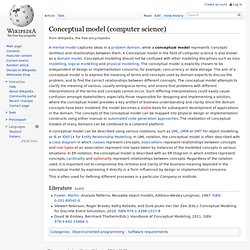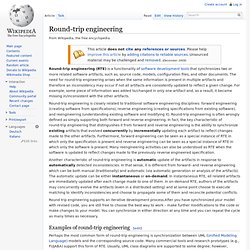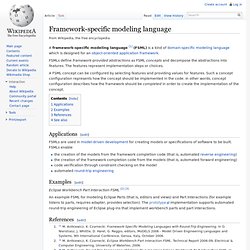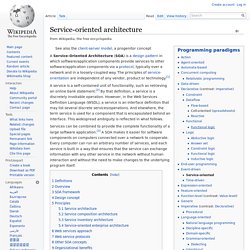

MDA en la práctica. Ejemplos con MDA. Ejemplo: Abstracción de la plataforma. Figura 3. Figura 2. Figura 1. Ejemplo: negocio-IT. Figura 4. Figura 3. Figura 2. Figura 1. Herramientas MDA. Soluciones RAD. Extensión de lenguajes de modelado. Generación de código. Principios del MDA. Acerca de OMG. Los Principios del MDA. Modelos y sus transformaciones. Transformaciones y refinamientos. Independencia de plataforma. Clasificación de modelos. MOF. Ejemplo. Acerca de MOF(Meta Object Facility)
Acerca de UML (Unified Modeling Language) Teoría del MDA en pocas palabras. Introducción de MDA en la empresa. Aumento de la Adopción. * Conjunto de Normas. Patrones y plantillas. Aplicaciones existentes. Adopción incremental. * Construcción de Modelos. Definición de Patrones. Areas principales Adopcion. Reutilizar Conocimiento. * Pensar en Servicios. * Arquitectura. * Definir Transformaciones. * ¿Por qué un Modelo?
Conceptual model (computer science) This is often used for defining different processes in a particular Company or Institute.

Fowler, Martin: Analysis Patterns, Reusable object models, Addison-Wesley Longman, 1997. ISBN 0-201-89542-0.Stewart Robinson, Roger Brooks, Kathy Kotiadis, and Durk-Jouke Van Der Zee (Eds.): Conceptual Modeling for Discrete-Event Simulation, 2010. Estado Actual del Modelado. Unified Modeling Language. The Unified Modeling Language (UML) is a general-purpose modeling language in the field of software engineering, which is designed to provide a standard way to visualize the design of a system.[1] It was created and developed by Grady Booch, Ivar Jacobson and James Rumbaugh at Rational Software during 1994–95 with further development led by them through 1996.[1] In 1997 it was adopted as a standard by the Object Management Group (OMG), and has been managed by this organization ever since.

In 2000 the Unified Modeling Language was also accepted by the International Organization for Standardization (ISO) as an approved ISO standard. Since then it has been periodically revised to cover the latest revision of UML.[2] Espectro del Modelado. Model Only. Model - Centric. Round-trip engineering. Round-trip engineering (RTE) is a functionality of software development tools that synchronizes two or more related software artifacts, such as, source code, models, configuration files, and other documents.

The need for round-trip engineering arises when the same information is present in multiple artifacts and therefore an inconsistency may occur if not all artifacts are consistently updated to reflect a given change. For example, some piece of information was added to/changed in only one artifact and, as a result, it became missing in/inconsistent with the other artifacts. Framework-specific modeling language. A framework-specific modeling language [1] (FSML) is a kind of domain-specific modeling language which is designed for an object-oriented application framework.

FSMLs define framework-provided abstractions as FSML concepts and decompose the abstractions into features. The features represent implementation steps or choices. A FSML concept can be configured by selecting features and providing values for features. Such a concept configuration represents how the concept should be implemented in the code. In other words, concept configuration describes how the framework should be completed in order to create the implementation of the concept. Applications[edit] Code Visualization. Reverse engineering. Reverse engineering has its origins in the analysis of hardware for commercial or military advantage.[2] The purpose is to deduce design decisions from end products with little or no additional knowledge about the procedures involved in the original production.

The same techniques are subsequently being researched for application to legacy software systems, not for industrial or defence ends, but rather to replace incorrect, incomplete, or otherwise unavailable documentation.[3] Motivation[edit] Reasons for reverse engineering: Reverse engineering of machines[edit] Code only. MDA. Object Management Group. Software Product Lines. A software product line (SPL) is a set of software-intensive systems that share a common, managed set of features satisfying the specific needs of a particular market segment or mission and that are developed from a common set of core assets in a prescribed way.

Software product lines are emerging as a viable and important development paradigm allowing companies to realize order-of-magnitude improvements in time to market, cost, productivity, quality, and other business drivers. Software product line engineering can also enable rapid market entry and flexible response, and provide a capability for mass customization. We are working to make software product line practice a dependable low-risk high-payoff practice that combines the necessary business and technical approaches to achieve success.
If you would like to gain expertise in these practices, see training in product lines. Benefits Product lines can help organizations overcome the problems caused by resource shortages. Learn More. Desarrollo de Software Basado enLíneas de Productos de Software. Service - Oriented Architecture. See also the client-server model, a progenitor concept A Service-Oriented Architecture (SOA) is a design pattern in which software/application components provide services to other software/application components via a protocol, typically over a network and in a loosely-coupled way.

The principles of service-orientation are independent of any vendor, product or technology.[1] A service is a self-contained unit of functionality, such as retrieving an online bank statement.[2] By that definition, a service is a discretely invokable operation. However, in the Web Services Definition Language (WSDL), a service is an interface definition that may list several discrete services/operations. And elsewhere, the term service is used for a component that is encapsulated behind an interface. Arquitectura Orientada a Servicios.
Dificultades de la MDA.